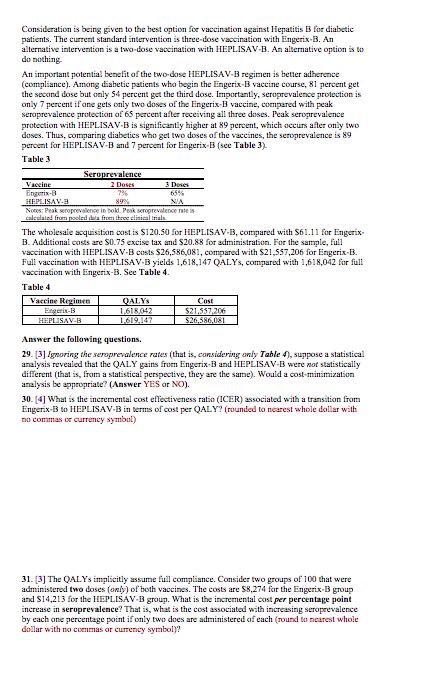Answered step by step
Verified Expert Solution
Question
1 Approved Answer
Consideration is being given to the best option for vaccination against Hepatitis B for diabetic patients. The current standard intervention is three-dose vaccination with
Consideration is being given to the best option for vaccination against Hepatitis B for diabetic patients. The current standard intervention is three-dose vaccination with Engerix-B. An alternative intervention is a two-dose vaccination with HEPLISAV-B. An alternative option is to do nothing. An important potential benefit of the two-dose HEPLISAV-B regimen is better adherence (compliance). Among diabetic patients who begin the Engerix-B vaccine course, 81 percent get the second dose but only 54 percent get the third dose. Importantly, seroprevalence protection is only 7 percent if one gets only two doses of the Engerix-B vaccine, compared with peak seroprevalence protection of 65 percent after receiving all three doses. Peak seroprevalence protection with HEPLISAV-B is significantly higher at 89 percent, which occurs after only two doses. Thus, comparing diabetics who get two doses of the vaccines, the seroprevalence is 89 percent for HEPLISAV-B and 7 percent for Engerix-B (see Table 3). Table 3. Seroprevalence Vaccine Engerix-B HEPLISAV-3 2 Doses 3 Dose 7% 89% 65% N/A Notes: Peak seroprevalence in bold. Peak seroprevalence rates calculated from pooled data from three clinical trials The wholesale acquisition cost is $120.50 for HEPLISAV-B, compared with S61.11 for Engerix- B. Additional costs are $0.75 excise tax and $20.88 for administration. For the sample, full vaccination with HEPLISAV-B costs $26,586,081, compared with $21,557,206 for Engerix-B. Full vaccination with HEPLISAV-B yields 1,618,147 QALYs, compared with 1,618,042 for full vaccination with Engerix-B. See Table 4. Table 4 Vaccine Regimen QALYS Cost Engerix-B 1,618,042 $21,557,206 HEPLISAV-B 1,619,147 $26,586,081 Answer the following questions. 29. [3] Ignoring the seroprevalence rates (that is, considering only Table 4), suppose a statistical analysis revealed that the QALY gains from Engerix-B and HEPLISAV-B were not statistically different (that is, from a statistical perspective, they are the same). Would a cost-minimization analysis be appropriate? (Answer YES or NO). 30. [4] What is the incremental cost effectiveness ratio (ICER) associated with a transition from Engerix-B to HEPLISAV-B in terms of cost per QALY? (rounded to nearest whole dollar with no commas or currency symbol) 31. [3] The QALYs implicitly assume full compliance. Consider two groups of 100 that were administered two doses (only) of both vaccines. The costs are $8,274 for the Engerix-B group and $14,213 for the HEPLISAV-B group. What is the incremental cost per percentage point increase in seroprevalence? That is, what is the cost associated with increasing seroprevalence by each one percentage point if only two does are administered of each (round to nearest whole dollar with no commas or currency symbol)?
Step by Step Solution
★★★★★
3.45 Rating (152 Votes )
There are 3 Steps involved in it
Step: 1
To calculate the incremental cost per percentage point increase in seroprevalence we need to determine the difference in cost between the two groups E...
Get Instant Access to Expert-Tailored Solutions
See step-by-step solutions with expert insights and AI powered tools for academic success
Step: 2

Step: 3

Ace Your Homework with AI
Get the answers you need in no time with our AI-driven, step-by-step assistance
Get Started



